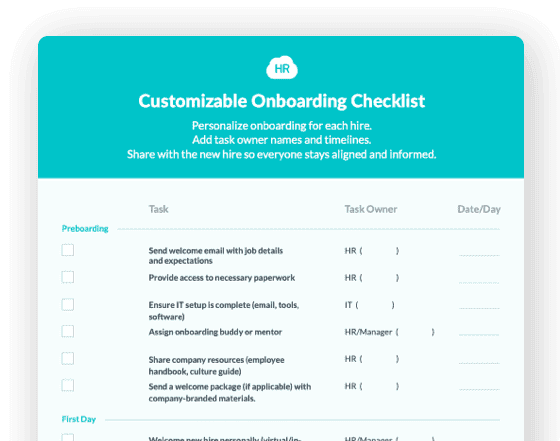

 Cut onboarding time
by 60%—here's the
Ultimate Checklist
that helped do it.
Cut onboarding time
by 60%—here's the
Ultimate Checklist
that helped do it.

Oftentimes workplace wellness options are considered benefits employees can utilize during their time. Perhaps a discounted gym membership. Healthy eating options at breaks and lunches. Or reduced fitness or yoga class costs from a local instructor. Unfortunately, businesses leave the responsibility entirely up to the employees to make fitness a priority. Offering on-site wellness programs helps prevent health risks and work-related injuries. These programs also allow companies to empower their staff with regard to health and fitness, increasing productivity, morale, and retention.
Five Fitness Programs for the Workplace
Making employee wellness programs a part of company culture and available onsite during working hours is an important health benefit to employees. Employees will be empowered to make healthier choices that carry over while they are not in the office as well. Here are five fitness programs that can be offered in the workplace and help employees avoid getting injured on the job.
Walking Groups
It doesn’t take breaking a sweat to benefit your body. Walking at a pace that gets the heart pumping, whether walking in nature or using a treadmill, increases your synovial fluid. This fluid surrounds our joints, keeping them limber and moving efficiently. For office workers who don’t have much movement in their daily routines, getting up and moving around to create synovial fluid is highly beneficial to their joints and health in their working environment.
Stretching Exercises
Overexertion is one of the leading causes of workplace injuries to team members. Properly preparing muscles before working them plays a key role in preventing muscle strain and overexertion. Providing a guided stretching routine for just three to five minutes before staff starts their duties can reduce workplace injuries.
Social Intranet Software that Encourages Employee Communication

Ergonomic Programs
How employees complete their job duties may never be a second thought to some. The main factor is that the job gets done, right? Wrong. Organizations should do their due diligence to resolve health-related issues and promote physical health. Perhaps staff members are poorly postured because the equipment is placed improperly. A resolution may be as simple as moving a computer monitor up or down to reduce neck strain. Given employees are doing these repetitive tasks daily, organizations should do what they can to make the work as comfortable as possible for their employees.
Water Intake Challenges
Hydration is an important part of health and wellness, given that 60% of the human body is made up of water. A simple yet effective way to encourage employees regarding health and wellness programs is to start small. A water intake challenge is a perfect first step. Making the challenge a friendly competition amongst departments is a great way to get everyone involved in their health and the company initiative. Winners could get custom water bottles and bragging rights.
Resetting Exercise Groups
Repetitive stress injuries (RSIs) are the second most common workplace injury. These injuries are caused due to the same muscle movements repeatedly straining the same muscle groups. However, by implementing resetting exercises, these injuries can be significantly reduced and even eliminated. When muscles are used, they are contracted. This in itself is not surprising; however, the muscles opposite of those being contracted are loosened. If those muscles are not engaged throughout the day, they will not support the counter muscles, which are frequently used, creating an off-balance, if you will. By providing targeted engagement and contraction, all the muscles are strengthened and continue to provide support while on the job.
5 Tips for Implementation
Knowing a few different wellness programs that could be implemented in your business is fine and well. However, implementing them may seem like a nearly impossible feat. Follow these three helpful tips for program implementation to avoid injury or illness and ensure success for your company.
Implement Group Programs During Work Hours
When group programs are available, it is far more challenging for individuals to decline participation. Additionally, staff will be far more likely to participate by offering the program during working hours. It could involve five minutes after they clock in and before they start their shift or taking an extra five minutes after lunch to reset. By allowing this time while “on the clock,” employees will see that their employers are taking their health and wellness seriously. This will boost company morale, employee happiness, and long-term employee retention.
Offer Incentives
Providing a benefit for participating in wellness programs is a great way to get staff members motivated. It could be similar to training incentives, or it might be as simple as promotional water bottles after stretching. Or the department winners of the water intake challenge receive new company-branded water bottles or custom towels. Or, if workplace injuries go down by a predefined amount, everyone gets a half-day off.
Find Out How Much You Can Save by Switching to Workmates.
and save upwards of 60%

Create a Schedule
Determine when these programs will take place, and make a schedule for employees to follow. If employees are expected to participate and take it seriously, employers must also buy in and participate. Employer buy-in means you will need consistency on who is expected to participate, when they will do so, and where. A schedule will also help build structure into a new workplace routine - with workplace wellness at its core.
Make it Applicable
All of the fitness programs listed above are applicable in any business organization. However, the extent of the program or the actual exercises performed will vary based on job duties. For example, office positions will focus more on movement and resetting their upper body, while physical laborers or assembly line workers will need a more targeted approach. Be sure you are implementing a program to meet each employee's specific work-related fitness needs.
Educate Staff
Finally, You also need to educate your staff. Let employees know you are implementing the program and explain why and how it will help them individually and the whole company. Why does their health matter to you?
New program implementation requires a company-wide announcement. However, once the program becomes a part of your company’s culture, you’ll be able to introduce these programs during the new employees’ onboarding process.
Conclusion
The implementation may seem daunting for organizations that currently do not have onsite workplace exercise programs. Organizations will begin seeing success by formulating a plan for employee inclusion and participation. It will soon become part of the company culture, like weekly meetings, company shirts, etc.
But what about the nay-sayers? Those that may have tried to implement workplace fitness programs, and it was unsuccessful? Perhaps they are reluctant to try this initiative again, which may be understandable. For those, we say - why did it fail?
Before writing off attempting a workplace wellness program again, consider what was done before. Did you offer the program during working hours? Were employees incentivized to participate? Were programs offered in a group setting or only for individual workouts? Was there consistency in program availability from week to week? Were the staff adequately educated on the wellness initiatives? Just because it may not have worked in the past does not mean the future is dimly lit. Consider following these programs to see a fitness program successfully embraced in your organization.
Author Bio:
Aaron Smith is an LA-based content strategist and consultant in support of STEM firms and medical practices. He covers industry developments and helps companies connect with clients. In his free time, Aaron enjoys swimming, swing dancing, and sci-fi novels.
Stop Conflict Before it Begins with
a Culture of “Thank You”

Keep Reading
45 Boss Day Messages That Actually Mean Something (2026 Guide)
When is Boss Day 2026? Mark your calendar for October 16, 2026 — the annual opportunity
Birthday Wishes for Coworkers: 50+ Messages That Build Workplace Connection
A coworker's birthday isn't just another calendar date—it's a meaningful opportunity to
Embracing Diversity: Recognizing Different Cultures in the Workplace
Workplaces today reflect the incredible diversity of the world around us. People bring
Like What You Hear?
We'd love to chat with you more about how HR Cloud® can support your business's HR needs. Book Your Free Demo

Build a Culture of Recognition. Boost Engagement. Guaranteed.
Workmates empowers employees to stay informed, connected, and appreciated—whether they’re on the front line, in the office, or remote. Recognition drives 12x higher engagement.Trusted by industry leaders in every sector




Cut Onboarding Costs by 60%.
Take the confusion and follow-ups out of onboarding with automated workflows, digital forms, and structured portals—so new hires ramp faster 3X quicker.Trusted by industry leaders in every sector





